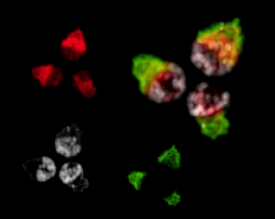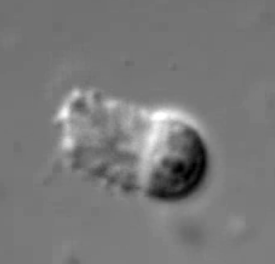Live-action films of worm sperm contain clues to male fertility
Nov. 10, 2011 -- Mouse sperm propel themselves with a whip-like molecular tail that lashes back and forth. Sperm in the roundworm Caenorhabditis elegans crawl along using a flat, fibrous foot called a pseudopod. They couldn’t be more different, and yet they depend on the same enzymes to help them develop and move about, according to a new study by SF State researchers.

Fluorescent images of C. elegans sperm. Shown in red are GSP-3/4, phosphatases required for fertility, white are Membranous Organelles, and green is Major Sperm Protein, a C. elegans protein important for motility. GSP-3/4 is shown to be an important regulator of MSP in the Wu et al paper. Photo credit: Jui-ching Wu and Diana Chu
The startling discovery could guide scientists in new directions as they explore how the DNA is organized in sperm, and packaged properly to deliver to the embryo, said Diana Chu, an associate professor of biology.
Researchers have identified similar enzymes in human sperm, Chu said, although it is not yet clear what role they might play in human fertility.
Chu and her colleagues observed the enzymes -- called PP1 phosphatases -- in live worm sperm with the help of a powerful confocal microscope. Mini-movies of the enzymes at work showed that they were necessary for separating chromosomes during sperm cell division—a role they also play in mouse sperm cell division.
Then things started to get a little strange in the lab. The researchers discovered that worm sperm that lacked the enzymes were stuck in place, unable to move around on their pseudopods. Mice sperm without the enzymes are similarly immobile, even though they have a tail-like flagellum instead of a flat foot. “It’s a very similar thing even though the sperm look really different,” Chu said.
Could the same enzymes be connected to such different ways to get around? Susan Mirsoian and Aiza Go, graduate students in Chu’s lab, kept seeing the enzymes collect after cell division “in a crescent-shaped pattern where the pseudopods would be,” Chu recalled, but it seemed so unlikely that Chu had Mirsoian and Go repeat the experiments to be sure that the result was not a mistake.
Persistent experiments confirmed the enzymes’ important role in worm sperm movement. Pseudopods move the sperm through a “treadmilling” motion, and the SF State researchers now say that the enzymes help to disassemble and reassemble the pseudopod’s molecular skeleton in a way that pushes the treadmill forward.

Micrograph of a C. elegans ameoboid sperm
Photo credit: Aiza Go and Diana Chu
Even stranger, Chu and her colleagues found, the phosphatases in worms and mice seem to have evolved independently in each species. This suggests that they act similarly because they solve a similar adaptive “problem,” rather than acting similarly because they share an evolutionary ancestor.
Compared to most other cells in an organism, sperm undergo a radical transformation to become compact and mobile delivery systems for paternal DNA. The DNA is squeezed together so tightly that it is closed off to the molecular machinery that would normally transcribe new genes and translate them into new proteins.
Without new proteins to control sperm development, Chu explained, the phosphatases fill in as “post-translational machinery that acts as an on/off switch” for controlling key events such as chromosome segregation and sperm motility.
The study suggests these fertility regulators don’t have to be evolutionarily conserved to be important.
SF State co-authors on the paper, published online in the journal Genetics, include Jui-ching Wu, Mark Samson, Thais Cintra, Tammy Wu, Margaret Jow and Eric Routman.
Share this story:
